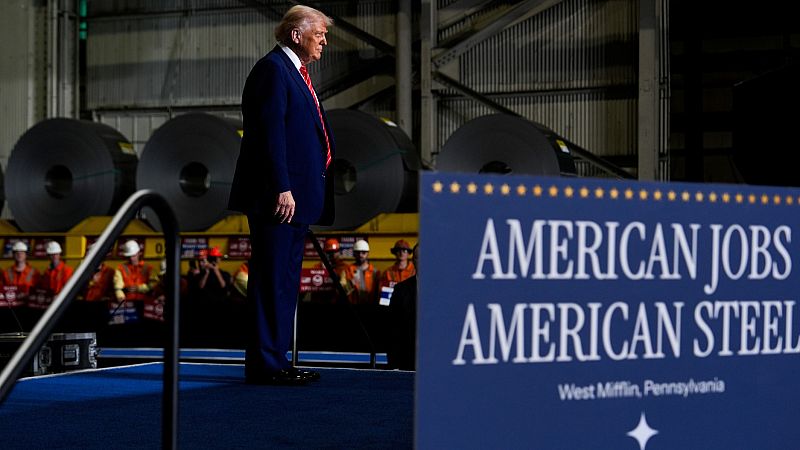Why copper, aluminium and steel are at the core of Trump's MAGA ideology

Like the US government's country-specific tariffs, the hefty 50% levies on all steel, copper and aluminium imports go beyond economics — reflecting Trump's desire to reclaim once-dominant US industries and rally his blue-collar base.
"Much of the motivation for tariffs on the base inputs of production, such as copper, is primarily a political motivation," David Stritch, a senior FX Analyst at Caxton, told Euronews.
"Trump has on several occasions become frustrated at the reversal in the production of all three materials, away from the United States, which was the dominant global producer as recently as the 1980’s, and towards Chile for copper and China for steel and aluminium," he continued.
Trump has long framed steel and aluminium as the backbone of American strength, linking their production to economic survival as well as national security. During his first term in 2018, he underscored just how central he believes these industries are.
"A strong steel and aluminium industry are vital to our national security. Absolutely vital," Trump said.
"Steel is steel. You don't have steel, you don't have a country. Our industries have been targeted for years and years — decades, in fact — by unfair foreign trade practices leading to the shuttered plants and mills, the laying off of millions of workers, and the decimation of entire communities. And that's going to stop, right? It's going to stop," he declared at the time.
When it comes to copper, the US currently imports around half of its resources, mostly from Chile and Canada.
On Wednesday, copper prices fell sharply before the 1 August deadline for the implementation of new tariffs, with US copper futures sinking 20% to around $4.55 or €3.94 per pound, marking the largest intra-day fall on record.
This came after US copper prices surged to new records in July when Trump first announced the levy. Again taking investors by surprise, the president then announced this week that the raw material — as opposed to semi-finished products — would be exempt from the duty, threatening less of a supply squeeze. Imports of copper concentrate and cathodes won't be affected by new levies, although shipments of wire, pipes, and sheeting will be.
Meanwhile the doubling of steel and aluminium tariffs, to 50% from their previous 25% tariff rate, has significantly raised US domestic metal prices, cutting off cost-competitive imports and increasing volatility for manufacturers.
Higher input costs and shrinking availability are forcing US companies to consider reshoring their investments and redesigning their supply chains.
Whether or not tariffs will actually boost domestic production nonetheless remains to be seen, as levies imposed by Trump during his first term failed to do so. By 2024, US steel output was actually 1% lower than in 2017, before Trump’s initial tariffs, while aluminium production had declined by nearly 10%.
According to recent analysis, Trump's tariffs could raise manufacturing costs by up to 4.5%, squeezing narrow-margin sectors like EVs and appliances, as well as delaying investment in key manufacturing hubs across the country.
Industries 'snatched away' from the US
For most of the 20th century, the United States was the world’s top copper producer until Chile took this title, marking the end of US dominance. Today, Chile remains the largest global producer of the metal.
In terms of steel production, the US peaked in the early 1970s before the industry faced a prolonged collapse, deepened by a series of recessions. Cheaper and more efficient systems in Japan, South Korea, Europe and elsewhere undercut high-cost US integrated steel mills. A strong dollar also made foreign steel even cheaper, while domestic plants were burdened with aging equipment, high labour contracts and rising environmental costs.
Steel towns — the ones Trump now wants to reinvigorate nearly 50 years later — collapsed economically, despite government interventions to keep them afloat. This is why the region from New York through the Midwest continues to be called the Rust Belt, referring to corroding mills and production sites that have long fallen out of use.
In terms of aluminium, the US was the world’s leading aluminium producer for much of the 20th century, largely due to the abundance of cheap electricity needed for smelting and strong domestic demand from defence, aerospace and automotive industries. In the early 2000s, China overtook the US as the leading producer of aluminium.
"Trump’s greatest base of support, primarily blue collar non-college educated men, has seen the largest drop in employment opportunities as a result of this offshoring," Stritch told Euronews.
Increasing costs, especially in green-adjacent industries
Trump’s sweeping 50% tariffs on copper, steel and aluminium are likely to disrupt industries that rely heavily on these materials, from construction and defence and even green technologies.
"Practically, all three materials are used extensively from solar panels to car batteries, one may assume that it would thus be the US manufacturing base that suffers to the largest extent," Stritch continued.
Nowhere is this pressure felt more acutely than in sectors like electric vehicles and renewable energy, where these metals are essential and profit margins are already minimal.
Stritch added: "We may further speculate that owing to the high tariff placed on these goods and the general fragility of the electric car market at present, the high inputs of all three materials and the thin average industry profit margin of 5%, EV producers may endure the worst of the increased input costs."
Today

